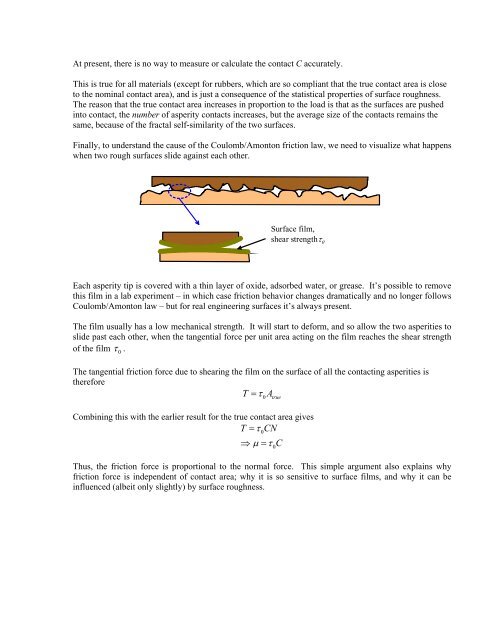Chapter 2 Review of Forces and Moments - Brown University
Chapter 2 Review of Forces and Moments - Brown University
Chapter 2 Review of Forces and Moments - Brown University
Create successful ePaper yourself
Turn your PDF publications into a flip-book with our unique Google optimized e-Paper software.
At present, there is no way to measure or calculate the contact C accurately.<br />
This is true for all materials (except for rubbers, which are so compliant that the true contact area is close<br />
to the nominal contact area), <strong>and</strong> is just a consequence <strong>of</strong> the statistical properties <strong>of</strong> surface roughness.<br />
The reason that the true contact area increases in proportion to the load is that as the surfaces are pushed<br />
into contact, the number <strong>of</strong> asperity contacts increases, but the average size <strong>of</strong> the contacts remains the<br />
same, because <strong>of</strong> the fractal self-similarity <strong>of</strong> the two surfaces.<br />
Finally, to underst<strong>and</strong> the cause <strong>of</strong> the Coulomb/Amonton friction law, we need to visualize what happens<br />
when two rough surfaces slide against each other.<br />
Surface film,<br />
shear strengthτ 0<br />
Each asperity tip is covered with a thin layer <strong>of</strong> oxide, adsorbed water, or grease. It’s possible to remove<br />
this film in a lab experiment – in which case friction behavior changes dramatically <strong>and</strong> no longer follows<br />
Coulomb/Amonton law – but for real engineering surfaces it’s always present.<br />
The film usually has a low mechanical strength. It will start to deform, <strong>and</strong> so allow the two asperities to<br />
slide past each other, when the tangential force per unit area acting on the film reaches the shear strength<br />
<strong>of</strong> the film τ<br />
0<br />
.<br />
The tangential friction force due to shearing the film on the surface <strong>of</strong> all the contacting asperities is<br />
therefore<br />
T = τ A<br />
0 true<br />
Combining this with the earlier result for the true contact area gives<br />
T = τ<br />
0CN<br />
⇒ μ = τ C<br />
Thus, the friction force is proportional to the normal force. This simple argument also explains why<br />
friction force is independent <strong>of</strong> contact area; why it is so sensitive to surface films, <strong>and</strong> why it can be<br />
influenced (albeit only slightly) by surface roughness.<br />
0
















